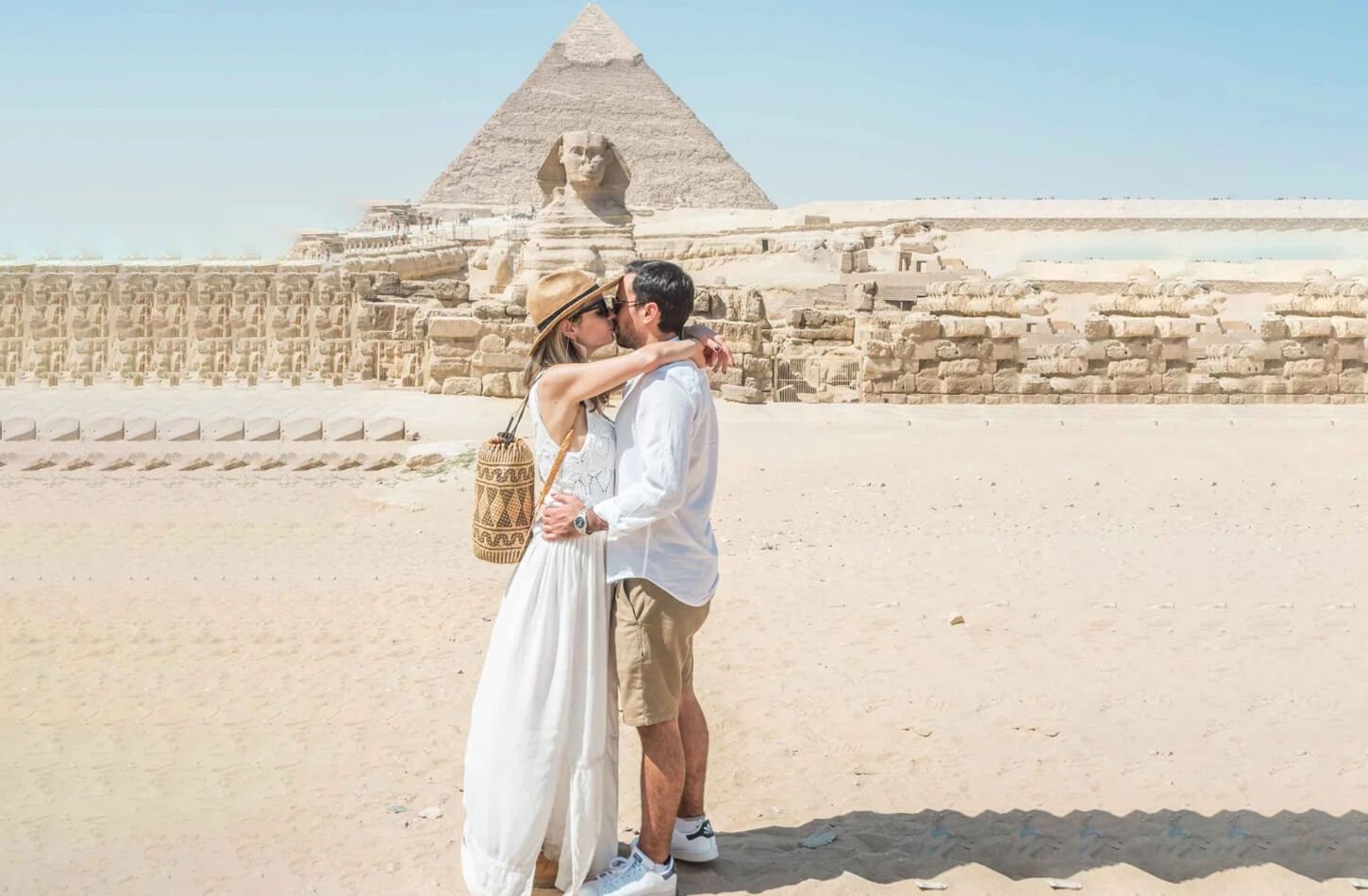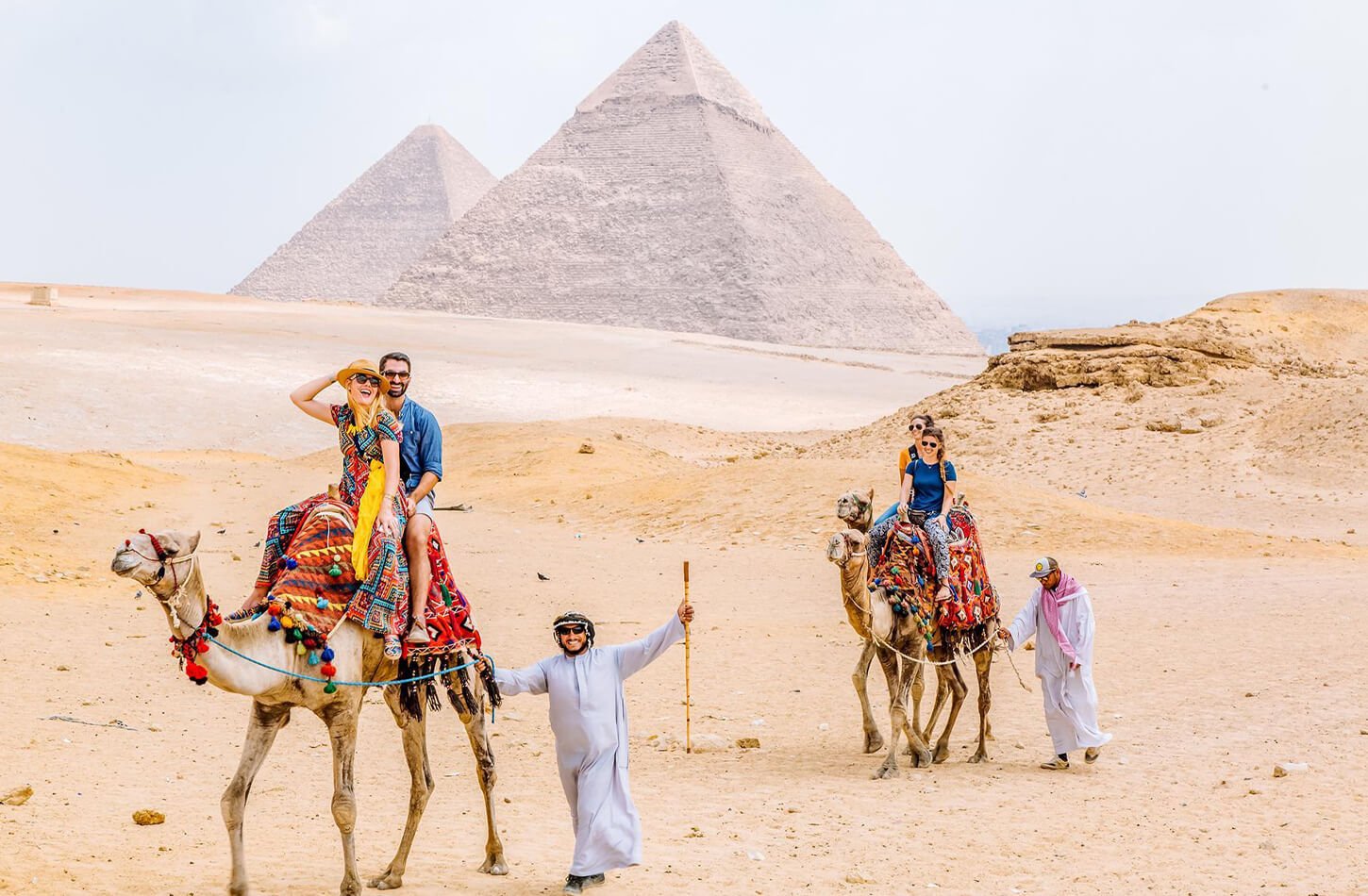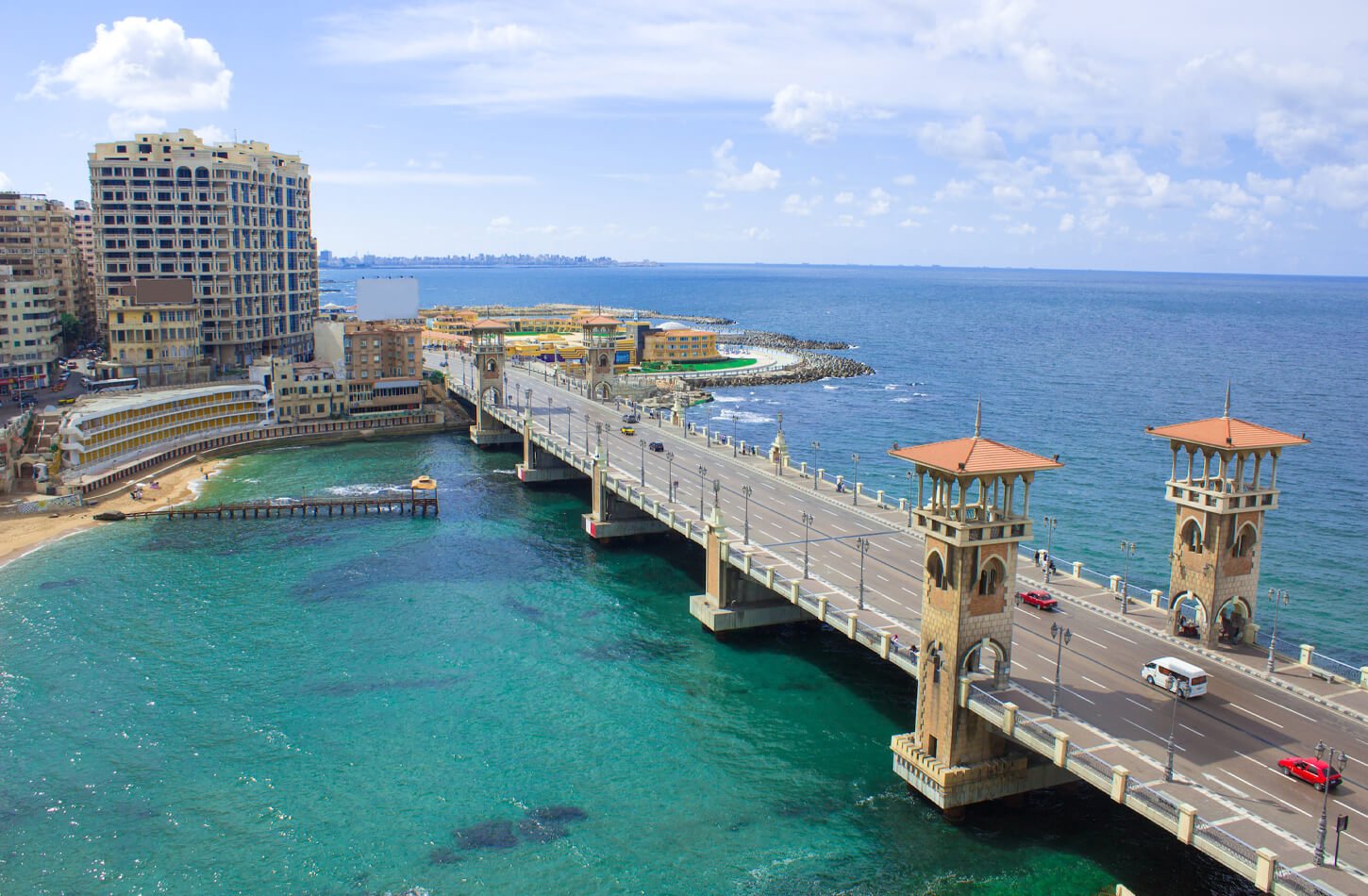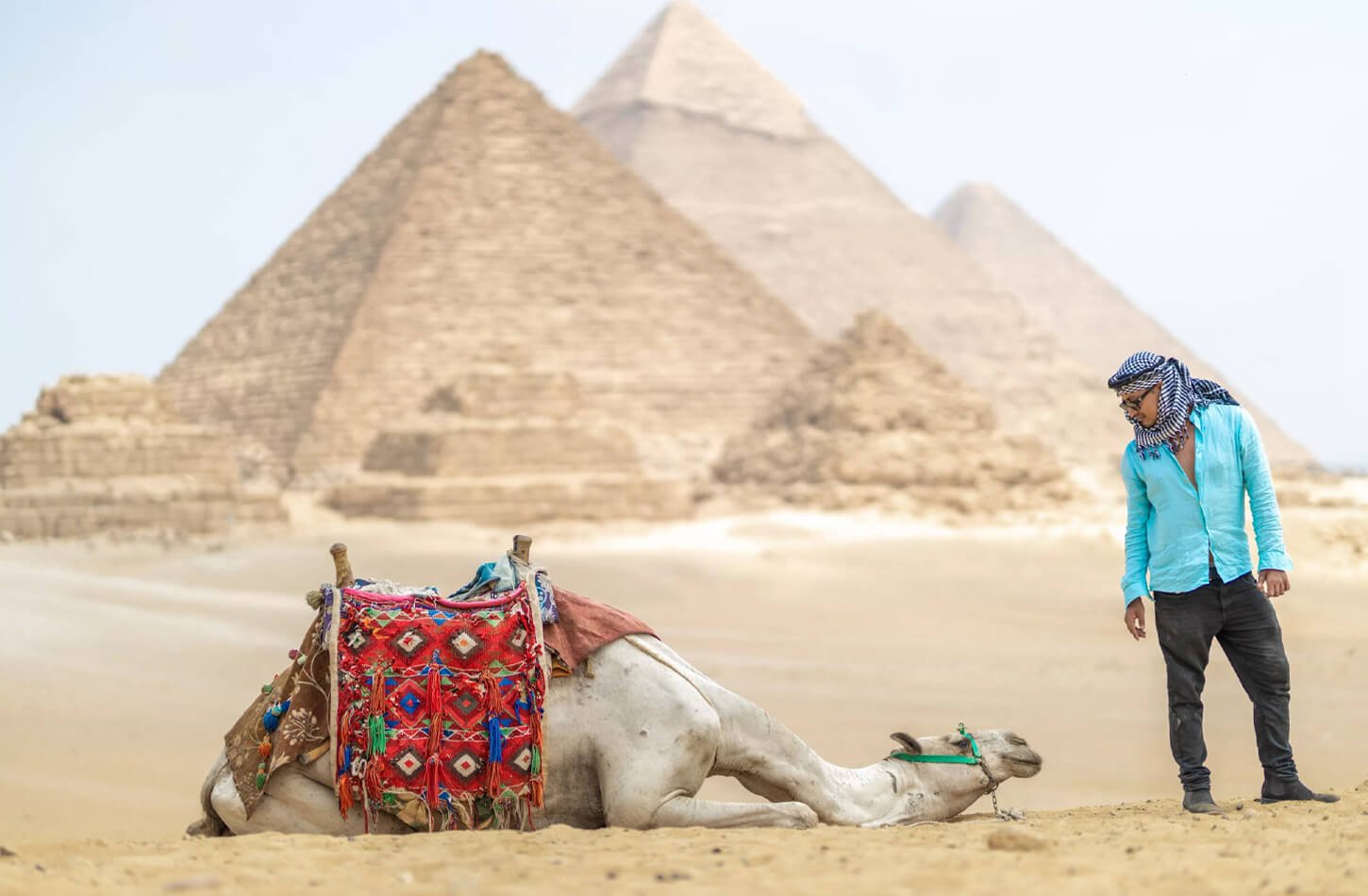Planning when to visit the Pyramids of Giza is key. These ancient wonders, built over 5,000 years ago, attract millions. The best time is from October to April, when it’s cooler.
It’s also good to avoid peak crowds. January to March is busy, with highs of 19°C in Cairo. Summer’s July heat makes midday visits hard.
Off-peak visits can be quieter and cheaper. Every moment here tells a story. Knowing when to go lets you walk where history happened, not just through crowds.
Why Timing Matters for Your Pyramids Experience
Choosing the right time to visit Egypt’s pyramids helps you avoid crowds, stay cool, and save money. Here are three key reasons why timing is important:
The Impact of Crowds on Your Visit
Weekends are the busiest, with Fridays and Saturdays filled with locals and tourists. For a quieter visit:
- Go on weekdays (Sunday-Thursday) to see fewer people.
- Arrive at opening (7 AM) to beat the crowds and get great photos.
- Shoulder seasons (March–April and September–October) have midweek crowds that are half the size of peak times.
Weather Considerations for Comfort and Photography
Deciding when to visit Egypt’s pyramids depends on your weather preference:
- Winter (Dec–Feb): Comfortable 10–20°C temperatures. Overcast skies make for dramatic photos.
- Summer (Jun–Aug): Visit mornings (7–9 AM) to avoid the heat. Sunset views are stunning but crowded.
- Spring/Autumn: March–May mornings are mild (20–30°C). September cools down by November, perfect for golden-hour shots.
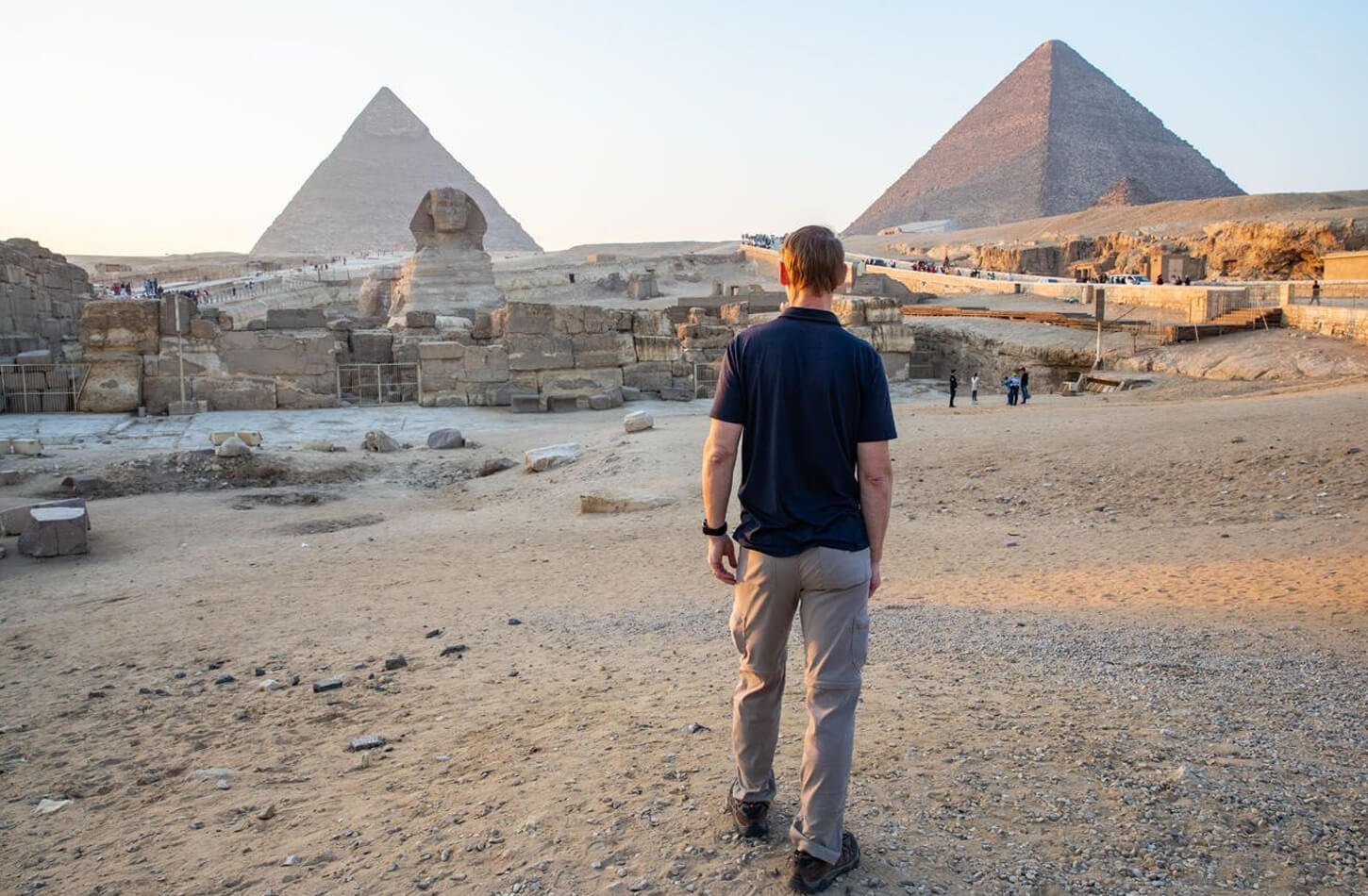
How Timing Affects Your Budget
Prices change with the seasons. Plan your trip to save money:
- High season (Oct–Feb): Entry fees go up 20% during holidays. Hotel prices are 30% higher than shoulder months.
- Shoulder seasons (Mar–Apr, Sept–Oct): Book flights 6 weeks in advance for discounts. Entry fees stay the same (e.g., 900 EGP for the Great Pyramid).
- Low season (May–Aug): Save 40% on tours but face summer heat. The Sound and Light Show costs $20 USD all year.
Timing your visit wisely turns a rushed tour into a memorable journey through 5,000 years of history.
The Best Time to Visit Egypt Pyramids: Seasonal Overview
Choosing the best time to visit the pyramids is key. You want comfort, fewer crowds, and good prices. Here’s a guide to Egypt’s seasons:
- Winter (November–February): Peak Season for Egypt Pyramids
- Temperatures: 12°C to 22°C (54°F–72°F) during the day.
- Pros: Clear skies for photography and cooler visits to sites like the Great Pyramid of Khufu.
- Cons: Crowds peak in December and January; hotel rates rise up to 40%.
- Spring (March–May: Shoulder Season)
- Temperatures climb to 28°C (82°F) by April, with fewer tourists than winter.
- April is ideal—warm but not hot, with prices dropping post-February.
- Summer (June–August: Low Season)
- Daytime highs hit 40°C (104°F), but crowds shrink by up to 60%.
- Budget travelers save 30% on accommodations but should plan visits before 10 AM or after 4 PM.
- Fall (September–October: Shoulder Season)
- Temperatures drop to 30°C (86°F) by October, making this a top recommended time to explore Egypt pyramids.
- Golden-hour photography thrives under autumn sunlight, with fewer tourists than summer.
April and November are the best times. April for spring blooms and November for cooler evenings. Use this guide to plan your trip. Choose comfort, cost, or solitude.
Winter in Egypt: December to February
Winter makes the Giza Plateau perfect for visiting the pyramids. The weather is great for exploring ancient sites. Daytime temperatures are between 66°F and 95°F, ideal for avoiding the summer sun.
Mornings can be cool, so bring layers for early visits.
- Climate perks: The dry skies and clear afternoons are great for photos. The morning haze clears by 10 a.m., showing the pyramids in all their glory.
- Crowd management: Expect big crowds, more so during Christmas and New Year. Try visiting on weekdays or before 9 a.m. to avoid the crowds.
December to February is busy with people escaping cold winters. But, being flexible can help. The West Bank Marathon in January adds fun to the area. Book your stay early, as prices go up during holidays.
If you visit in late December, watch out for fog. It might delay morning tours.
Pro tip: Visit Cairo’s museums in the cooler evenings. Then, return at sunrise to see the pyramids alone under the sky.
Spring at the Pyramids: March to May
Spring is a great time to visit the Egypt pyramids. March starts with highs of 24°C, ideal for exploring. By April, it gets warmer to 29°C, but it’s less crowded than winter.
May is warm, up to 32°C, but mornings and evenings are cool. This makes sightseeing comfortable.
- March: March has cool mornings and sunny afternoons. It’s less crowded, making it easier to see places like the Great Sphinx. Nights can get chilly, so pack layers.
- April: April is special because of the desert wildflowers. They turn the sand golden and white. It’s also less crowded, making it perfect for photos. Book tours early to get a good spot.
- May: May gets warmer during the day, but mornings are cool at 17°C. The pyramids are less crowded, and sunset views are great.
Spring has its perks, but watch out for khamsin winds (dust storms). Visit early or late to avoid glare. You can save up to 30% on hotels compared to winter.
April is a hidden gem with good weather and fewer crowds. Don’t miss local festivals like Sham al-Naseem in April. It celebrates spring with kite-flying near the Nile.
Summer Visits: June to August
Summer is hot, but it’s also a great time for those who want to avoid the crowds. If you’re planning to visit the Egypt pyramids during off-peak times, June to August can be a good choice. Just make sure you plan well to stay comfortable while exploring.
Beat the Heat: Smart Preparation
- Drink lots of water: Carry drinks with electrolytes and refillable water bottles. It’s very hot, so staying hydrated is key.
- Wear light clothes: Choose fabrics that breathe, hats that cover your face, and clothes that protect you from the sun.
- Watch the weather: Sandstorms can happen suddenly. Always check the forecast before you go out.
Summer’s Hidden Benefits
- Less people around: You can see the pyramids without waiting in long lines.
- Save money: Hotels and tours might give you discounts of up to 40% during the low season.
- Perfect photos: The clear skies and long shadows make for amazing photos of sunrises and sunsets.
Timing Tips for Comfort
Go to the pyramids before 9 AM or after 4 PM when it’s cooler. Take breaks in shaded cafes or museums during the hottest part of the day. Tip: The Sphinx area opens early. Get there by 8 AM for cooler air and fewer people.
Fall at Giza: September to November
Fall at Giza is a great time to see the pyramids. The weather is nice, and there are fewer people. This makes it a perfect time to visit.
The Perfect Balance of Weather and Crowds
Each fall month has its own benefits:
- September: It’s warm during the day, but cooler in the morning. There are fewer people as the summer ends.
- October: The weather cools down to the 70s and 80s. There are more people, but it’s still not too busy.
- November: It gets even cooler, with temperatures in the 60s and 70s. It’s a great time for photos before winter starts.
Photographing the Pyramids in Autumn Light
Autumn light makes the pyramids perfect for photos:
- September: Take photos at dawn or dusk for warm, golden light.
- October: The long shadows at sunrise and sunset add depth to your photos.
- November: The clear skies and sharp light are ideal for wide shots and sunrises and sunsets.
Plan your visit for the best weather and light. November is the best month for these reasons.
Time of Day: Optimizing Your Pyramids Experience
Make the most of your visit by choosing the top times for visiting the pyramids. Find out the recommended time to explore Egypt pyramids for amazing experiences. Here’s how to pick the best time for crowds, weather, and light:
- Early Morning (Opening to 9 AM):
- Get there at opening—7 AM (April–Sept) or 8 AM (Oct–March)—to avoid crowds.
- The soft morning light is perfect for photos. Wear layers because mornings can be cold in winter.
- It’s great for sunrise shots if you’re there by 7 AM in summer.
- Mid-Morning (9 AM–Noon):
- Crowds are still okay, making it good for guided tours or families.
- The light is still great for photos, but it gets hot after 10 AM in summer.
- Midday (Noon–3 PM):
- The sun is very strong, but there are fewer people as groups take a break for lunch.
- Visit the 9 Pyramids Lounge, 5 minutes away, for shade and refreshments.
- In winter, it’s cooler, making this a better choice.
- Late Afternoon (3 PM–Closing):
- The golden hour lighting is perfect for photos as the sun sets.
- Crowds are smaller, and it’s cooler. Stay until closing for a peaceful visit.
Consider the Light and Sound Show (7 PM winter/7:30 PM summer) for a magical end to your visit. Try to avoid weekends (Fridays/Saturdays) for less crowded times. The recommended time to explore Egypt pyramids is when you balance light, comfort, and quiet. Your special pyramid moment awaits with the right timing.
Avoiding Peak Tourist Hours: Insider Strategies
To make the most of your time at the Pyramids of Giza, know when to stay away from the peak season for Egypt pyramids. Follow these tips for a quieter and more enjoyable visit:
Weekday vs. Weekend Visits
- Go on Tuesdays and Wednesdays for fewer people—Egyptian school groups usually have Mondays and Thursdays off.
- Get there by 7:30 AM to see the site before the tour buses arrive at 10 AM.
- Stay away from weekends (Fridays/Saturdays) when lots of Egyptians visit.
Holiday Periods to Plan Around
- International holidays like Christmas (Dec 25) and Easter attract big crowds—book your stay early if you’re coming then.
- Egypt’s Eid al-Fitr (dates vary each year) brings locals, while Sham El Nessim (April/May) is for family picnics near the pyramids.
- Off-peak travel to Egypt pyramids is possible during Ramadan’s midday hours, but evening festivities add cultural charm.
Combine these tips with early morning visits and weekday trips for a less crowded Giza Plateau. Also, check local event calendars for big events like the Cairo Film Festival in November to plan your trip.
Special Access Options Based on Timing
Get special access to the Pyramids by visiting at the right time. Here’s how to make your visit unforgettable:
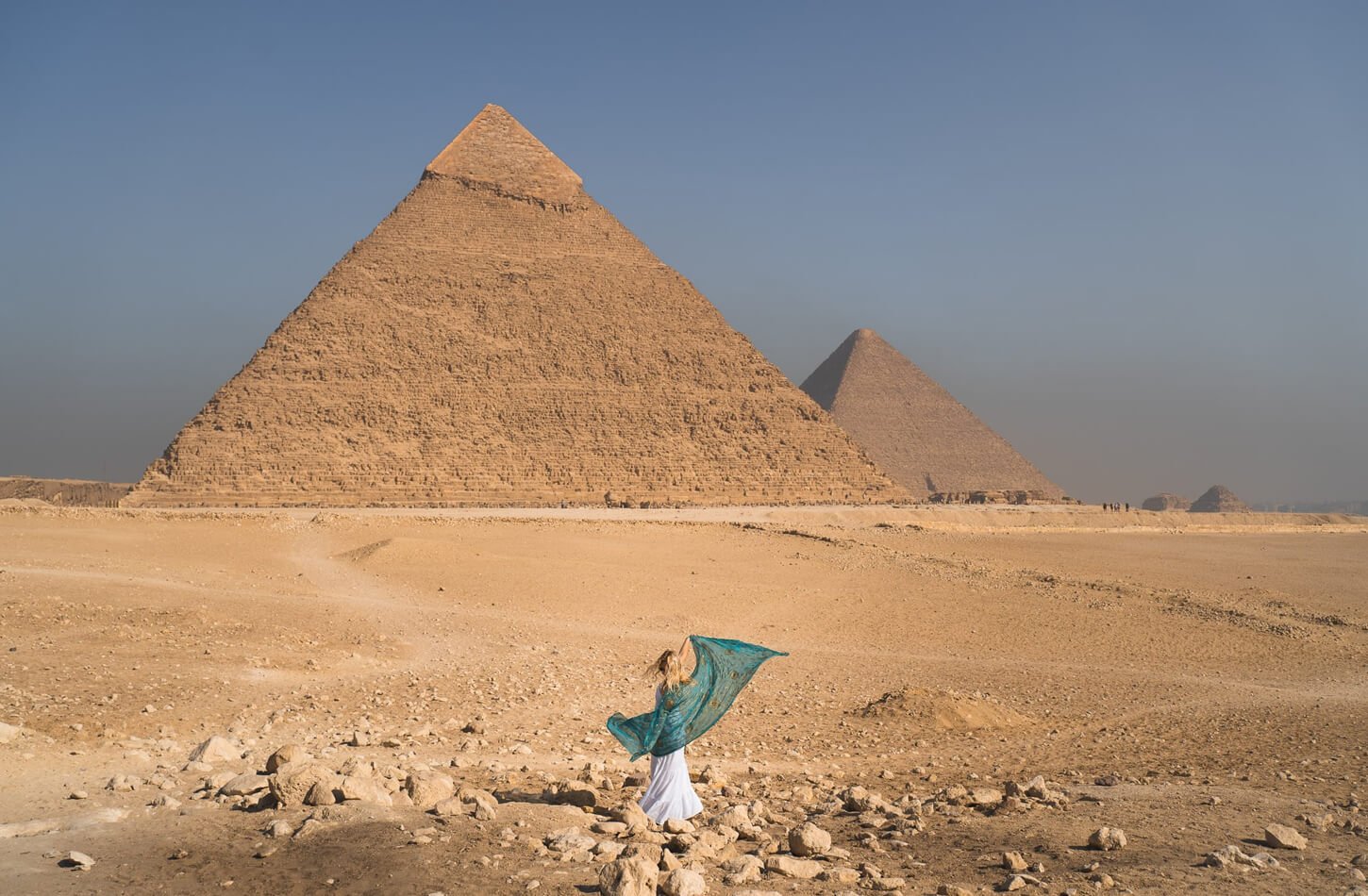
Sunrise and Sunset Opportunities
- Recommended time to explore Egypt pyramids: Book a private tour for sunrise. It’s quiet and the light is beautiful. Winter mornings are cool and perfect for exploring.
- Sunset visits are stunning. Arrive 30 minutes early to get the best photos.
- Private tours give you early entry. You’ll miss the busy hours.
Special Events and Limited Entry Options
- Optimal timing to visit Egypt pyramids for events: The Sound and Light Show is at 6:30 PM in winter and 7:30 PM in summer. It’s old but the Sphinx looks amazing at night.
- Seasonal events like solstice alignments offer special access. Check local guides for these dates.
- Limited-entry tours like the 7 AM private access are rare. Book 2–3 weeks ahead.
Combine these options with a Sound and Light Show ticket (300 EGP for adults) or a private tour (varies by provider). Make your visit special. Always check with tour operators about availability and timing.
Planning Around Egyptian Holidays and Festivals
Plan your visit to Egypt’s pyramids during the country’s lively festivals. This can make your trip even more special. Major holidays can change your travel plans:
- Ramadan: Nights are filled with markets and family time. Days are quieter, but evenings are lively. Check when places open.
- Eid Al-Fitr & Eid Al-Adha: Expect festive vibes and big crowds. Visit early to beat the rush.
- Cairo International Film Festival (November): This event brings filmmakers and fans. It’s a great time to see the pyramids. Book your stay early.
- Sham El-Nessim (April 23): A spring festival with picnics by the Nile. Giza will be busy, but it’s fun.
- Moulid El-Nabi (varies): Celebrates the Prophet’s birthday with parades. Some places might close early, so check first.
- Wafaa El-Nil (August 15): A celebration of the Nile’s flooding. Enjoy river events and cool pyramid visits at night.
Remember to check the Islamic calendar for Ramadan and Eid. National holidays like Revolution Day or Armed Forces Day might change transport plans. Visit during special events like the Film Festival in November for a memorable trip.
Conclusion: Making the Most of Your Egypt Pyramids Adventure
Choosing the best time to see the pyramids depends on what you want. Do you want good weather, affordable stays, or perfect photos? Here are some tips to help you plan:
For the best weather, go in November, March, or April. These months have mild temperatures and fewer people. Winter is cooler but busier, while summer is very hot.
Autumn in November has nice weather and great light for photos. Budget travelers might like June–August for lower prices. But, it’s very hot, so wake up early.
Photography lovers should visit in October for beautiful sunsets. Families might prefer school breaks. But, September is quieter and cheaper.
Remember to wear light clothes, a hat, and sunscreen. Bring 2 liters of water for desert walks. Spend at least three hours exploring, including the Sphinx and Panoramic Point.
Check the Grand Egyptian Museum’s opening hours and events. The Abu Simbel Sun Festival happens in February and October. It’s a special cultural event.
The Grand Egyptian Museum will soon show King Tut’s treasures. When to visit the pyramids is up to you. But, with careful planning, every season can be amazing. Let these tips make your trip as special as the pyramids.
Read our Related Article:
